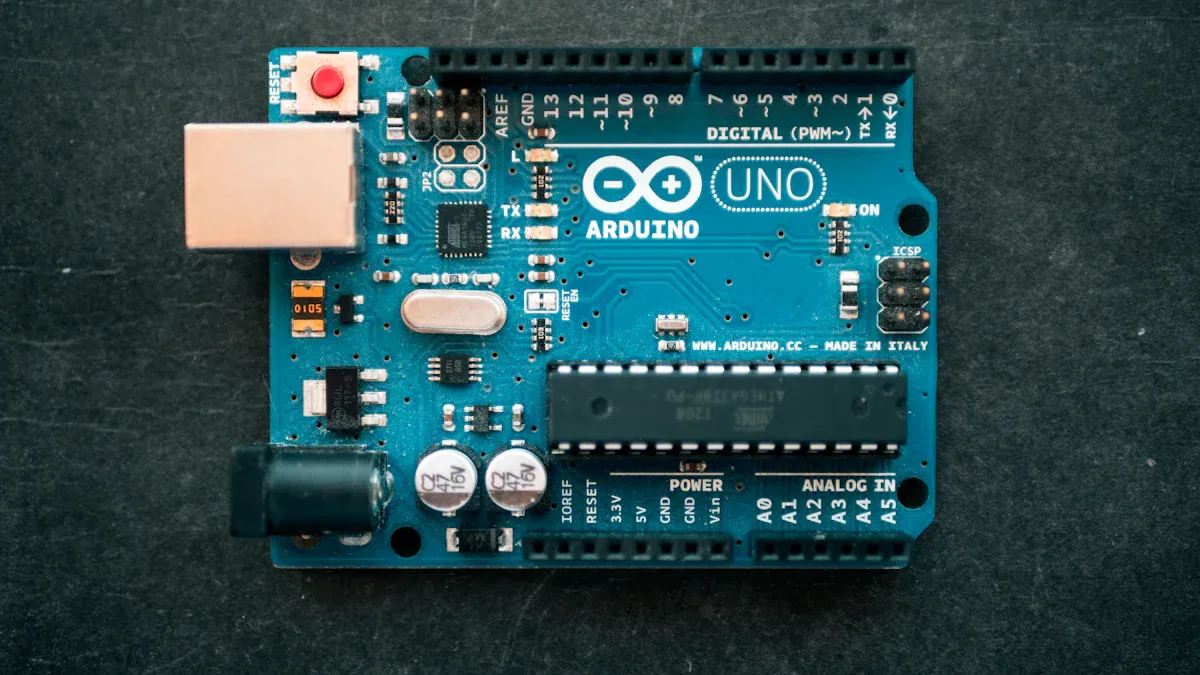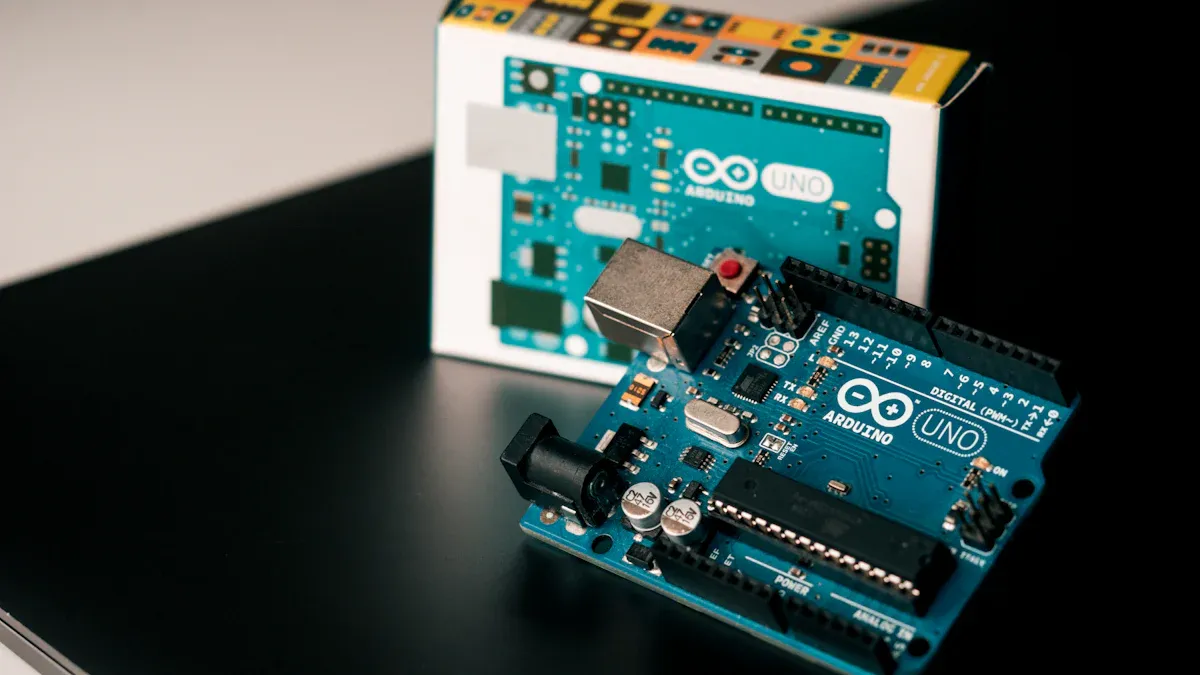IRF3205 vs IRF540N, Choosing the Right MOSFET and how they work?

Choosing the right MOSFET is crucial for circuits. IRF3205 and IRF540N are both N-channel MOSFETs, and they vary in current, resistance, and voltage handling capabilities. These differences make them suitable for different applications. Factors like power loss, speed, and resistance influence their performance. For instance, IRF3205 is ideal for high-power circuits due to its low resistance, while IRF540N is better suited for general-purpose tasks. Understanding these specifics helps individuals select the right component, especially when exploring integrated circuits for sale to meet their needs.
Key Takeaways
Pick the IRF3205 for high-power uses. It can handle 110A and has low resistance of 8mΩ. This makes it great for motor drivers and inverters.
Use the IRF540N for everyday tasks. It works with voltages up to 100V and is good for LED dimming and small motors.
Learn about threshold voltage (Vth) and on-resistance (Rds(on)). These decide how well a MOSFET works in your circuit.
Key Factors in Picking a MOSFET
What is Threshold Voltage (Vth)?
Threshold voltage (Vth) is the smallest voltage needed to turn on a MOSFET. The IRF3205 and IRF540N have a Vth range of 2.0V to 4.0V. This range works well with most microcontrollers and logic circuits. But, the gate voltage must be higher than Vth to fully turn on the MOSFET. If the voltage is too low, the MOSFET won’t switch completely. This can cause heat and waste energy. Knowing Vth helps ensure the MOSFET works properly in precise tasks.
Why On-Resistance (Rds(on)) Matters
On-resistance (Rds(on)) shows how much resistance exists when the MOSFET is fully on. Lower Rds(on) means less power loss and less heat. The IRF3205 has a very low Rds(on) of 8mΩ, which is great for high-power uses. The IRF540N has a higher Rds(on) of 44mΩ, making it better for general tasks. Below is a table showing typical Rds(on) values:
Metric | Value |
|---|---|
Typical Rds(on) | 0.032Ω |
Maximum Rds(on) | 0.065Ω |
Lower offered resistance | 0.04Ω |
Picking a MOSFET with low Rds(on) is key for efficient high-current circuits.
Gate Voltage and Switching Speed
Gate voltage affects how fast a MOSFET turns on and off. Both IRF3205 and IRF540N switch quickly, making them good for fast-changing circuits. Faster switching saves energy during state changes, improving efficiency. For example, the IRF3205 is great for motor drivers and inverters because it handles high currents quickly. The IRF540N works well for LED drivers and small motors, where slower speeds are fine.
IRF3205: Features and Applications
Technical Details of the IRF3205
The IRF3205 is a strong n-channel MOSFET for high-power uses. It comes in a TO-220 package with three pins: Source, Gate, and Drain. This MOSFET can handle up to 55V and 110A, making it great for high-current circuits. Its low on-resistance (Rds(on)) of 8mΩ helps save energy and reduce power loss. It also switches quickly and has a tough design, making it reliable in tough conditions.
Main specifications include:
Voltage limit (V_DSS): 55V
Max current: 110A
Power handling: up to 200W
Temperature range: -55°C to 175°C
Gate charge (Qg): 146 nC @ 10V
Fully avalanche rated and RoHS compliant
These features make the IRF3205 perfect for fast switching and power-saving tasks.
High-Power Application Performance
The IRF3205 works well in high-power setups because it handles high currents easily. Its design reduces heat, keeping it stable under heavy use. It’s often used in motor controls, power supplies, and renewable energy systems. For example, in motor controls, it lowers heat and power loss, helping devices last longer. Its quick switching also makes it efficient for circuits under 100kHz.
Specification | Value |
|---|---|
Power Dissipation (Max) | 200W (Tc) |
Vgs (Max) | ±20V |
Gate Charge (Qg) (Max) @ Vgs | 146 nC @ 10 V |
Operating Temperature | -55°C ~ 175°C (TJ) |
The IRF3205 is a top choice for industries like cars, telecom, and green energy.
Common Uses for the IRF3205
The IRF3205 is flexible and used in many high-power systems. It’s often found in:
Solar energy inverters
Backup power systems (UPS)
Electric car chargers
DC motor controllers
Battery chargers and power supplies
These examples show how the IRF3205 is reliable in tough jobs. Its efficiency and strength make it important in modern electronics.
IRF540N: Features and Applications
Technical Specifications of the IRF540N
The IRF540N is a flexible n-channel MOSFET for medium-power tasks. It has a TO-220AB package, which makes it easy to install and cool. This MOSFET can handle up to 100V and 33A, making it useful for many circuits. Its on-resistance (Rds(on)) ranges from 0.032Ω to 0.065Ω, helping it work efficiently with little energy loss.
Parameter | Value |
|---|---|
Typical Drain to Source On Resistance | 0.032Ω |
Max Drain to Source On Resistance | 0.065Ω |
Operating Temperature Range | -55°C to +175°C |
Package Type | TO-220AB |
RoHS Status | RoHS Compliant |
These details show the IRF540N is dependable and works well in electronics.
Performance in Motor Control and General Applications
The IRF540N is great for motor control and general circuits. It handles fast switching and works well with PWM signals. This allows it to adjust motor speeds accurately. Its low resistance keeps it cool, even during long use. This makes it perfect for small motors, relays, and power supplies.
The IRF540N also works well in LED dimming and flashing. It provides precise brightness control, making it popular for LED drivers. It connects easily with microcontrollers like Arduino or Raspberry Pi, making it useful for automation projects.
Common Use Cases for the IRF540N
The IRF540N is used in many modern devices, such as:
Switching High-Power Devices: Controls motors, relays, and power supplies.
Motor Speed Control: Adjusts motor speeds with PWM signals.
LED Dimming and Flashing: Controls brightness for lighting systems.
High-Speed Switching: Works in DC-DC converters and fast circuits.
Converters and Inverters: Manages voltage changes in power supplies.
Microcontroller Logic Switching: Works with Arduino or Raspberry Pi for automation.
Both IRF3205 and IRF540N are n-channel MOSFETs, but the IRF540N is better for higher voltage and general uses.
Comparing IRF3205 and IRF540N

Differences in Technical Specifications
The IRF3205 and IRF540N are both N-channel MOSFETs. However, they have different features. The IRF3205 is better for high-current tasks. It can handle 110A and has a low resistance of 8mΩ. The IRF540N supports up to 33A but has a higher resistance of 44mΩ. The IRF540N can manage higher voltages, with a limit of 100V compared to the IRF3205's 55V.
Specification | IRF3205 | IRF540N |
|---|---|---|
Drain-Source Voltage (Vds) | 55V | 100V |
Continuous Drain Current (ID) | 110A | 33A |
On-Resistance (Rds(on)) | 8mΩ | 44mΩ |
Power Dissipation (Pd) | 200W | 150W |
Gate Threshold Voltage (Vgs) | 2.0 - 4.0V | 2.0 - 4.0V |
These specs show the IRF3205 is great for high-power circuits. The IRF540N works well for general uses.
Performance Comparison in Real-World Scenarios
In real-life use, the IRF3205 is better for high-current needs. It works well in motor drivers, inverters, and battery chargers. Its low resistance reduces energy loss and heat, making it reliable.
The IRF540N is better for higher voltage tasks. It is used in LED drivers, small motors, and microcontroller projects. It is popular for hobbyists and professionals because it works with many circuits.
Specification | IRF540N | IRF3205 |
|---|---|---|
On-resistance (R_DS(on)) | 0.032Ω (typical) | 8mΩ |
Maximum Current Capacity | 33A | 110A |
Voltage Tolerance | 100V | 55V |
This table shows how each MOSFET performs in different situations. It helps users pick the right one.
Cost, Availability, and Integrated Circuits for Sale
The IRF540N is cheaper and easier to find. Its specs make it a good choice for general projects. The IRF3205 costs more but is worth it for high-power needs. Both come in TO-220 packages, which fit most circuits.
If you want affordable parts, the IRF540N is a good pick. For high-current and efficient tasks, the IRF3205 is a better investment.
Step-by-Step Guide to Choosing the Right MOSFET
Understanding Your Project's Power Needs
Knowing your project's power needs is the first step. Calculate the voltage and current your circuit requires. Use tools like simulation software or code libraries to help. These tools show how changes, like load size, affect power.
Think about peak current and voltage spikes for reliability. For example, motor circuits may need MOSFETs that handle sudden current surges. Check technical guides or ask experts for advice on these calculations.
Matching MOSFET Features to Your Project
After knowing your power needs, match them to a MOSFET's specs. Follow these steps to choose wisely:
Focus on Losses: Look at conduction and switching losses, not just power dissipation.
Calculate Power Loss: Use ( P = I^2 \times R_{ds(on)} ) to find conduction losses.
Balance Losses: Pick a MOSFET that reduces both conduction and switching losses.
Use J/K Method: Compare MOSFETs using J (switching loss per charge) and K (conduction loss per resistance).
For instance, the IRF3205 is great for high-current tasks due to its low Rds(on) of 8mΩ. The IRF540N, with higher voltage tolerance, is better for general uses.
Beginner Tips for Electronics
New learners should start by understanding MOSFET datasheets. Look at key specs like Vds, Id, and Rds(on) to know what the MOSFET can do. Manufacturer notes also explain how to use them correctly.
Try simple projects like motor controllers or LED dimmers to practice. The IRF540N works well with Arduino for automation projects. The IRF3205 is better for high-power tasks like battery chargers or inverters.
💡 Tip: Always add a flyback diode to circuits with motors. This protects the MOSFET from voltage spikes.
By following these tips, even beginners can pick the right MOSFET for their projects.
Both IRF3205 and IRF540N are N-channel MOSFETs, but they work best in different ways. The IRF3205 is great for high-current tasks because it has low resistance (8mΩ). The IRF540N can handle higher voltages (up to 100V) and is better for general uses.
Feature | IRF3205 | IRF540N |
|---|---|---|
Current Capacity | 110A | 33A |
Voltage Tolerance | 55V | 100V |
On-Resistance | 8mΩ | 44mΩ |
Knowing your project needs helps you pick the right one. Use the IRF3205 for high-power jobs like motor drivers. Choose the IRF540N for simpler tasks like LED dimming.
Tip: Always check your circuit's voltage and current needs before picking a MOSFET. This ensures it works well.
FAQ
What are the main differences between IRF3205 and IRF540N?
Both are N-channel MOSFETs, but they handle current and voltage differently. The IRF3205 supports up to 110A and 55V. The IRF540N works with 33A and 100V.
Parameter | IRF3205 | IRF540N |
|---|---|---|
Current Capacity (Id) | 110A | 33A |
Voltage Tolerance (Vds) | 55V | 100V |
On-Resistance (Rds(on)) | 8mΩ | 44mΩ |
When should you use IRF3205 instead of IRF540N?
Pick the IRF3205 for circuits needing high current. It’s great for motor drivers and inverters. Its low resistance (8mΩ) helps save energy in powerful setups.
💡 Tip: Use IRF3205 for tasks needing up to 110A current.
Can beginners use IRF540N for simple projects?
Yes, the IRF540N is perfect for beginners. It works well with microcontrollers like Arduino. Use it for LED dimming, small motors, or basic switching tasks.
✅ Note: The IRF540N handles higher voltage (100V), making it useful for many projects.
See Also
Understanding The IRF820 MOSFET For Power And Control
Key Specifications Of The MC9S12DJ256MFUE For Vehicles
Three Essential Features Of R5F64219JFB For Audio Gear
CALL US DIRECTLY
(+86)755-82724686
RM2508,BlockA,JiaheHuaqiangBuilding,ShenNanMiddleRd,Futian District,Shenzhen,518031,CN
www.keepboomingtech.com sales@keepboomingtech.com
